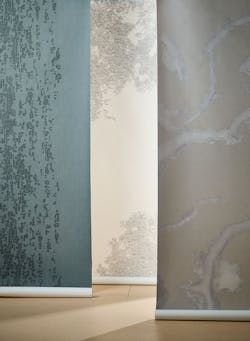NeoCon 2025 made clear that commercial design is moving into a new era. From smarter, more sustainable materials to deeper conversations around wellness, inclusion, and long-term impact, this year’s show wasn’t just about what’s new—it was about what matters. We’ve unpacked the standout trends and shared some ways designers can turn complex ideas into real-world solutions.
Alert! 🚨 Major Design Trends Ahead
1. Biophilic and wellness-focused spaces are growing in number and creativity. In response, products and presentations based on neuroscientific research continue to underscore the ability of fractal- and nature-inspired design to reduce stress.
What we saw: Textiles, wallcoverings, and acoustic systems designed using researched Fractal D Values enable designers to achieve stimulating or calm spaces that support neurodiversity and occupant well-being.
2. Circular and sustainable material innovation is shifting toward materials that can meet both environmental and performance standards without compromise. “Climate positive” is beginning to overtake “carbon negative,” reframing the conversation around materials that store more carbon than they emit—especially wood-based products.
What we saw: From thermally modified woods to bio-based materials, biodegradable plastics, and fully recyclable furnishings and finishes, manufacturers clarified the sustainability narrative to make sustainable materials and finished products more approachable for designers.
3. Durability, taste, and sustainability need reconciliation. With shorter lease cycles and longer-lasting materials, designers must balance the desire for novelty with sustainable practices. This raises critical questions about product life cycles, reuse, and aesthetics.
What we saw: To tackle these concerns, manufacturers emphasized furnishings that demonstrate modularity, adaptability, and disassembly, in support of evolving spaces that allow flexible planning and reconfiguration.
4. The trend toward sensory-rich spaces was discussed across several showrooms, particularly with furniture and seating manufacturers, to support occupant well-being. Sound, touch, and visual comfort continue to propel human-centered wellness design.
What we saw: 3D cork tiles, acoustic management products from ceiling to floor, and privacy pods with immersive sound environments can help designers prioritize acoustic and sensory integration, especially in workplaces that may have limitations on revised space planning.
5. Focused attention to tactile features by manufacturers will aid designers in telling a complete story in the built environment, evoking place, memory, and mood.
What we saw: Elevated textures and finishes, inspired by fashion, heritage, and nature, were evident all over—textiles, carpeting, engineered surfaces, and more.
Action Items 👉 From NeoCon Thought Leaders
1. Practice “attitudinal design” to address complex global challenges, as urged by designer Alice Rawsthorn. Design is a way of thinking and responding, she reiterated throughout her keynote.
Here’s how: Adopt an “attitude” that seeks creative solutions, cultivates social awareness, and identifies your responsibilities to the intended users of a space, rather than centering on form and functions.
2. Prioritize inclusion through co-creation and multidimensional thinking, recommended keynoter Annie Jean-Baptiste as well as I Hear Design podcast guest and IIDA president Cheryl Durst.
Here’s how: Ask “Who else?” and actively engage underrepresented voices. Design with people instead of for them, to realize spaces that reflect multifaceted human identities and experiences.
3. Operate from a mindset of resourcefulness, resilience, and reinvention. Keynoters Rawsthorn and Shazam founder Chris Barton detailed design journeys—both their own and others—that defied norms and lead to breakthrough ideas.
Here’s how: Welcome adaptive thinking and “creative persistence”—both independently and collaboratively—to innovate under constraints.
4. Integrate strategic foresight into your design process to better anticipate future trends.
Here’s how: Explore the IIDA’s Certified Design Futurist program and learn how it can empower you to speak a business-oriented language that positions you as a strategic advisor to clients, versus a service provider.
5. Embrace neuroscience and empathy to enhance human performance. Science Design Lab collaborators Dr. Richard Taylor (University of Oregon), Anastasija and Martin Lesjak (13&9 design studio), and Momentum representatives engaged NeoCon visitors with a highly anticipated presentation, as well as one-to-one showroom interactions that explored the possibilities of what advanced design techniques can do to improve healthcare, education, and high-stress environments.
Here’s how: Employ scientifically backed design principles—like fractals and nature-based patterns—to enhance emotional and cognitive well-being.
6. Reframe ROI as “return on influence” and long-term impact, as recommended by Jean-Baptiste.
Here’s how: Design for “the edge,” as Durst put it, to benefit the majority. Inclusive, delightful, and human-centered design not only expands markets but also fosters loyalty, wellness, and equity.
That wraps up our NeoCon 2025 analysis. We look forward to learning what 2026 will bring with the advent of Chicago Design Week!
About the Author
Robert Nieminen
Chief Content Director
Chief Content Director, Architectural Products, BUILDINGS, and interiors+sources
Robert Nieminen is the Chief Content Director of three leading B2B publications serving the commercial architecture and design industries: Architectural Products, BUILDINGS, and interiors+sources. With a career rooted in editorial excellence and a passion for storytelling, Robert oversees a diverse content portfolio that spans award-winning feature articles, strategic podcast programming, and digital media initiatives aimed at empowering design professionals, facility managers, and commercial building stakeholders.
He is the host of the I Hear Design podcast and curates the Smart Buildings Technology Report, bringing thought leadership to the forefront of innovation in built environments. Robert leads editorial and creative direction for multiple industry award programs—including the Elev8 Design Awards and Product Innovation Awards—and is a recognized voice in sustainability, smart technology integration, and forward-thinking design.
Known for his sharp editorial vision and data-informed strategies, Robert focuses on audience growth, engagement, and content monetization, leveraging AI tools and SEO-driven insights to future-proof B2B publishing.
Carrie Meadows
Editor-in-Chief
Carrie Meadows is Editor-in-Chief of interiors+sources (i+s), where she leads editorial strategy, content development, and brand storytelling focused on the people, projects, and innovations shaping the design industry. With more than two decades of experience in B2B media, she has built a career connecting technical expertise with creative insight—translating complex topics into meaningful stories for professional audiences. Before joining i+s in 2024, Carrie served as Editor-in-Chief of LEDs Magazine within Endeavor Business Media’s Digital Infrastructure & Lighting Group, guiding coverage of emerging lighting technologies, sustainability, and human-centric design. Her earlier editorial experience spans across Laser Focus World, Vision Systems Design, Lightwave, and CleanRooms, where she managed print and digital publications serving the optics, photonics, and semiconductor sectors.
An advocate for clear communication and thoughtful storytelling, Carrie combines her editorial management, SEO, and content strategy expertise to help brands and readers stay informed in a rapidly evolving media landscape. When she’s not crafting content, Carrie can be found volunteering at a local animal shelter, diving into a good crime novel, or spending time outdoors with family, friends, and her favorite four-legged friends.




